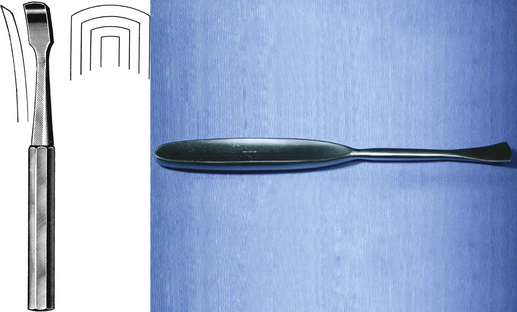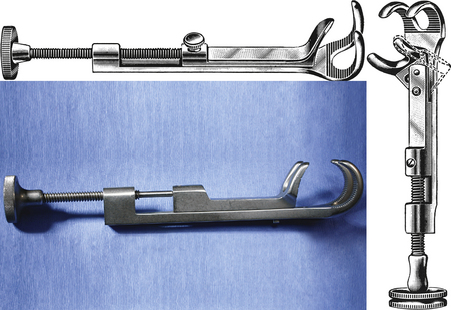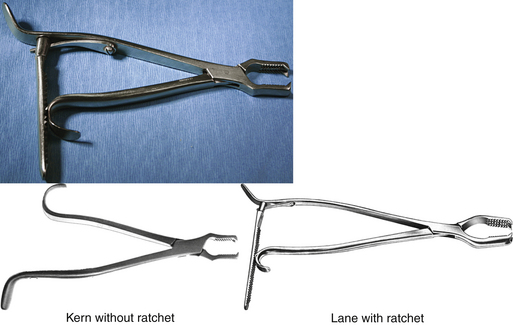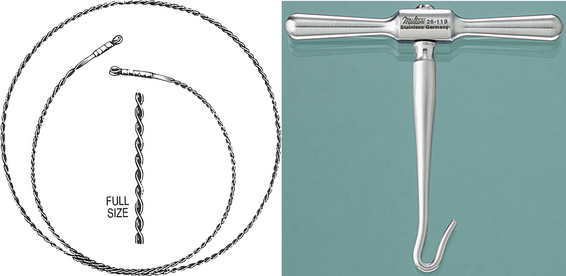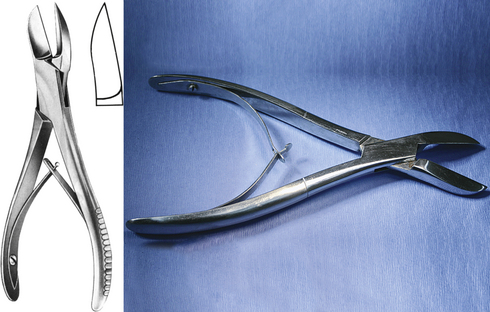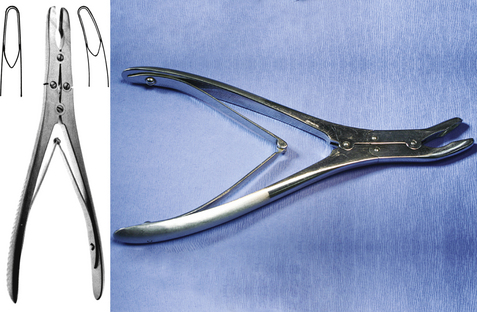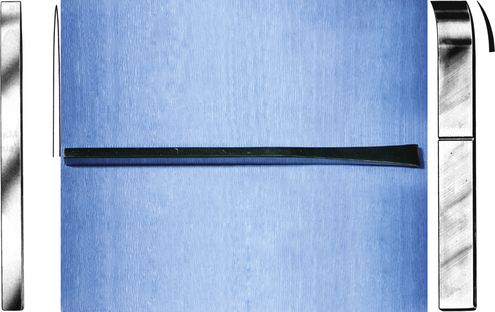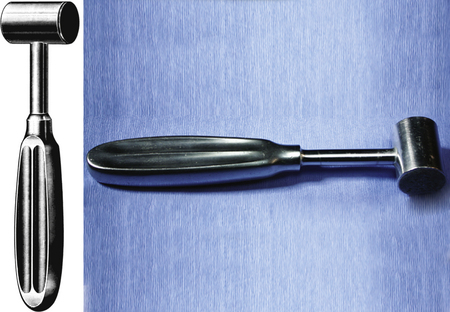CHAPTER 19 Orthopedic Instruments
This chapter covers the standard instruments found in general orthopedic work. It is by no means a comprehensive list of instruments that an orthopedic surgeon may have available.
INSTRUMENT
Periosteal Elevator
| FUNCTION | To work under and lift the periosteum or soft tissues away from the bone. |
| CHARACTERISTICS | A curved bladelike end has a handle. It may be 6½ to 10 inches long and may have a blunt or a sharp blade that is scooped or curved. There may be a blade on each end of the handle. |
INSTRUMENT
Lambert-Lowman Bone Clamp
| FUNCTION | To hold bone and bone fragments together for fixation with pins, screws, or plates. The clamp does so without causing further trauma to the periosteum. |
| CHARACTERISTICS | Curved jaws sit at the top of a square handle with a knob at the bottom, which is used to bring the jaws together. The jaw configuration can be 1 × 1, 2 × 1, or 2 × 2. The instrument’s length ranges between 4½ and 8 inches, and jaw lengths range from ¾ to 1½ inches. Some models allow the lower jaw to tilt. Lambert-Lowman is another name for an instrument that is basically the same but has a jaw with an angle that is slightly different. |
INSTRUMENT
Kern Bone-Holding Forceps
| FUNCTION | To hold bone and bone fragments together for fixation with pins, screws, or plates. Care must be taken to avoid clamping this instrument too tightly because doing so can cause bruising to the bone. |
| CHARACTERISTICS | The jaws are not as curved as those of the Lambert-Lowman clamp. They are held closed by a ratchet located at the bottom of the handles. Lengths range from 5¾ to 8½ inches, with or without the ratchet. The Lane looks very much like the Kern except that it has a greater jaw width and the length ranges from 13 to 17 inches. |
INSTRUMENT
Gigli Wire Saw and Handles
| FUNCTION | To cut through thick or heavy bone. |
| CHARACTERISTICS | A rough wire is attached to or can be attached to handles. The wire is placed around a bone or horn, and a back-and-forth motion cuts through the matter with minimal effort. |
INSTRUMENT
Liston Bone-Cutting Forceps
| FUNCTION | To cut bones. |
| CHARACTERISTICS | This heavy-jawed instrument has smooth scissorlike jaws used to break ribs or other small bones. It is 5½ to 8 inches long and has straight or angled jaws. It is available with a double-action handle that increases the power of the instrument. A larger version of this instrument, called the Stille-Liston forceps, is available in a 13-inch length, and the double-action handle is a standard feature. |
INSTRUMENT
Ruskin Rongeur
| FUNCTION | To remove or break up small chunks of bone, cartilage, or fibrous tissue. |
| CHARACTERISTICS | Small cups with sharp edges form the jaws of this instrument. It has double-action handles, which give it greater power when it is squeezed. It is 6 to 7¼ inches long and has jaw dimensions that range from 4 × 15- to 6 × 15-mm bites. The jaws can be angled or straight. They are also available with plain handles, which are commonly used on the smallest of bones and are called Adson, Luer, or Lempert rongeurs. |
INSTRUMENT
Bone Rasp
| FUNCTION | To smooth off rough edges of bones. |
| CHARACTERISTICS | Raised cross-hatches on the surface of this instrument look much like those on a file found on a carpenter’s workbench. However, the end may be pointed, blunt, or rounded and may be flat or convex. Lengths range from 8½ to 11 inches. The instrument is also called a Putti or a Fomon rasp. |
INSTRUMENT
Osteotome
| FUNCTION | To cut through or to shape bone. |
| CHARACTERISTICS | A tapered blade is situated at one end of a handle; the other end flares to accept the blow of a mallet. Osteotomes are 6½ to 9 inches long and vary in width from 6 to 38 mm. If the blade is curved, the instrument is referred to as a gouge. |
< div class='tao-gold-member'>
Only gold members can continue reading. Log In or Register to continue
Stay updated, free articles. Join our Telegram channel

Full access? Get Clinical Tree


